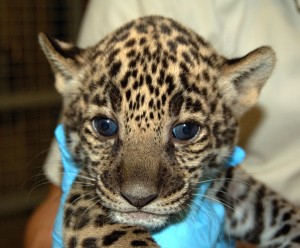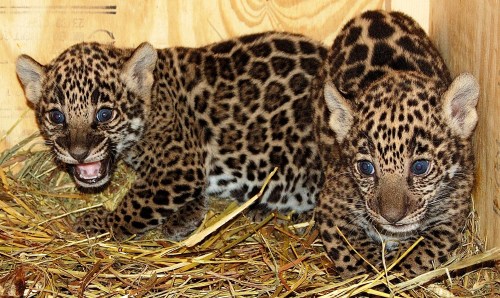
Pico guessed these jaguar cubs would get a lot of attention. Here is some more information about how the cubs came to be:
You may remember the post about the jaguars meeting each other for the first time back in June. Obviously the meeting was very successful. Keepers tracked the female’s cycles using behavioral cues like rolling, rubbing, vocalizing, and even though they were not physically together at this point, the male’s reactions and vocalizations from the adjoining den. Once the introduction was made, keepers, staff, and docents did an excellent job making animal observations to ensure the meeting stayed positive. After about 5 days, the female’s interest in (and tolerance for) the male dropped dramatically.
Jaguar gestation averages around 100 days. Keepers first started to suspect that something was up when the female continued to gain weight even after a diet reduction. They first attempted to collect her fecal matter for hormone analysis. However, because this process hadn’t been done prior to a suspected pregnancy, we didn’t have a baseline for our female and the initial results came back negative.
If you have ever had the chance to go on a behind-the-scenes tour of AMAZONIA, you will know about the state-of-the-art squeeze cage and scale that were built into the jaguar holding. Using the squeeze cage, keepers and vet staff were able to perform an ultrasound on the female jaguar while she was awake. Lots of training went into this process to make sure the female would remain calm. An awake ultrasound is much safer than having to anesthetize an animal. Ultrasound verified the presence of at least one cub.
A few weeks before the possible due date, nest boxes were moved into two of the dens to give the female a chance to get used to them before she needed them. They’re nothing fancy as you can see in the webcam. Just wooden boxes with some bedding.
On the morning of September 22nd, a keeper entered the jaguar holding area and was not greeted by the female jaguar as he had been every other day. When food was offered later in the day, the female still did not appear. It took several days before the female felt secure enough to leave her new babies. This behavior is very normal in big cats.
Keepers had to be very hands off at this point because our female had never had cubs before. We didn’t know what kind of mother she was going to be and the worse thing to do would be to stress the female so she abandoned or harmed the cubs. Hand-raising animals should only be done as a last resort. It’s much harder for animals to learn natural behaviors and have a chance of being socially accepted among their own kind. Plus hand-raised animals can be more dangerous because they are more willing to approach people instead of giving them respectful, and safer, space.
Over the next few weeks, several people reported hearing vocalizations from the nest box. Eventually, the female felt comfortable enough to move into the adjoining den where she was securely separated while a keeper quickly peeked into the nest box and saw… two little cubs! Normal litters are anywhere from one to four cubs. Jaguar cubs are born blind and deaf, but their ears and eyes open around 10 days. Since it had been more than 10 days at this point, they had their eyes open.
A few weeks later, the vet staff and keepers separated the female again and caught the cubs up to give them health checks and find out the sexes. At this point it’s clear that we have an excellent mother jaguar. As long as she remains comfortable, keepers are able to shift and secure her while they periodically weigh the cubs to make sure they are growing as they should.
And just to let you know, the cubs are not very cuddly. They have very sharp claws, which they use freely, and their teeth have now come in. Keepers use leather gloves to handle the cubs and will only be able to go in with them for a few more months. Once again, it’s better to be hands-0ff with wild animals so they stay wild and have the best chance of behaving and reproducing like wild animals.
The cubs were very wobbly the first time they exited the nest box. Now you can see them on the webcam confidently playing with each other and mom. The next step will be introducing them to the day room and then the exhibit. The cubs are still nursing at this point, but should start to show an interest in meat in a few more months. The cubs will remain with their mother until they are 1.5 – 2 years old based on the SSP’s recommendations. Then they will go to other zoos and have the chance to become mothers too!
Leave a comment if there is anything else you’d like to ask Pico about jaguars!

